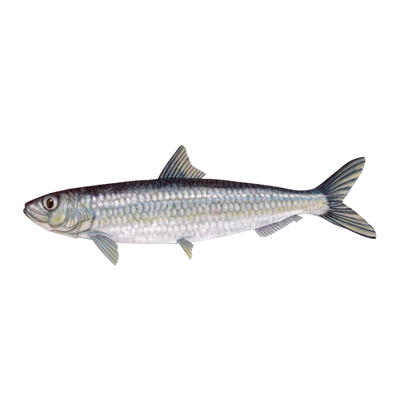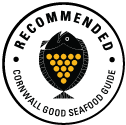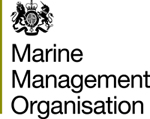

Delicious silvery fish. Cornish sardines are fabulous barbequed or grilled. They are high in omega 3 oils and are very good for you as well! Tiny soft bones can be easily chewed up and eaten.

Cornish vessels landing to Cornish ports
Ring nets are encircling nets used to catch midwater fish such as sardine, and anchovy. They are set around a shoal and a drawstring rope on the bottom of the net is pulled so the fish can’t escape.
Learn moreCornwall Good Seafood Guide rates fish on sustainability using a scale of 1 to 5.
1, 2 and 3 are recommended, Fish to avoid are rated 5.
We use the system devised by the Marine Conservation Society (MCS) so our scores are comparable with the scores produced by MCS for the UK and fisheries from all around the world. For more information on scoring click here.
Sardines (also known as Pilchard) are small silvery fish related to herring that shoal in mid water around the Cornish coast (at the Northern end of their natural range).They live at depths ranging between 10-100m (usually 25-55m by day, rising to 10-35m at night). Schools of juvenile fish tend to be separated from adults and are found closer inshore. Sardines are mature at a length of around 15 cm. They spawn in batches in spring and summer in the open sea or near the coast, producing 50,000-60,000 eggs with a mean diameter of 1.5 mm. After spawning, they migrate northwards to their feeding grounds and are then found inshore in coastal waters. In winter they migrate southwards. Pilchards usually have a length of 20cm, maximum is about 27cm. Maximum reported age is 15 years. They feed on planktonic crustaceans such as copepods. The main season for the fishery is August to January although they are sometimes caught outside this period.
This stock is assessed by the International Council for the Exploration of the Sea (ICES). The most recent assessment was published in 2023 using data up to 2023. The next assessment is expected in 2024.
Sardine in area 7 has been surveyed and assessed as a separate stock since 2017, via the CEFAS PELTIC survey. It was very data limited until 2021, when a benchmark was carried out to improve the quality of the assessment. No MSY-based reference points have been defined for this stock to indicate what would be a sustainable level of fishing or biomass. However, there is an estimated trigger point, to safeguard the biomass, which has been set at 120,751t. [ICES Stock assessment 2023]
Route 2 (data limited) scoring has been applied to this rating owing to the lack of a reference point for fishing pressure. Sardines are considered to have medium resilience to fishing. [FishBase]
Sardine is a short-lived species, and biomass can fluctuate considerably. While there have been some fluctuations since 2017, there has been an overall increasing trend. Biomass in 2023 was 456,482t – the highest since the time series began in 2017, and well above the trigger point. Therefore, there is no concern for the biomass of this stock. [ICES Stock assessment 2023]
There is no indicator for fishing pressure. For the first time in 2022, ICES provided stock-specific catch advice of no more than 6,906t. Total landings were 14,178t - above the advice and the 2018-2022 average (10,973t). [ICES Stock assessment 2023] This suggests that there could be concern for the fishing pressure. However, a number of caveats have been mentioned in relation to ICES advice for this stock, indicating that it may not be appropriate (further details below). Cefas have also provided separate catch advice for the MSC-certified component of the sardine fishery, indicating that higher catches would not be a threat to the biomass. Based on these caveats, and noting that the biomass has been able to increase under current levels of fishing, we do not consider there to be concern for fishing pressure.
Following the 2021 benchmark and in the absence of MSY-based reference points, ICES’ approach to developing catch advice involved using average catches for the preceding two years. However, ICES noted some caveats, including that the stock is only moderately exploited and could withstand higher levels of fishing pressure; that catches from the past decade had been low; and that harvest rates from the most recent two years were the lowest in the time series. Catches fluctuate based on changes in fleet activity and which species are being targeted. Therefore, these low catches were not indicative of stock size. [ICES WGHANSA 2021]
As a result of this, ICES noted that the 2021 benchmark would produce a low catch advice, and that the stock was likely to be able to support higher exploitation rates. [ICES WGHANSA 2021] The ICES approach in 2021 led to a harvest rate of 2.6% [ICES data limited short lived species workshop 2021], whereas in 2017 and 2018 it had been 7%. [MSC Certification Report 2022] It has been suggested that the approach may not be appropriate for moderately exploited stocks such as the Celtic Sea sardine. [ICES data limited short lived species workshop 2021]
In Cornwall, the Cornish Sardine Management Association (CSMA) have sought additional catch advice for their MSC-certified fishery, which accounts for over 50% of the total catches of this stock. Each year, the CSMA proposes an annual catch limit for its fleet, based on capacity. This is reviewed by Cefas based on the likelihood of keeping the stock below FMSY and the risk of reducing biomass to Blim. [MSC Certification Report 2022] In 2022, CSMA raised concerns about the new ICES approach and continued to liaise with Cefas for catch advice. In 2023, CSMA proposed an increased catch of 11,150t and Cefas advised that this rate of harvest would be precautionary and would not lead to overexploitation of the stock. [MSC Surveillance Report 2023]
Based on the above, ICES catch advice may not be appropriate for assessing fishing pressure until a new approach can be developed. ICES is expected to carry out an interbenchmark during 2024-2025.
The majority of sardines caught in Cornish waters are caught using ring nets. Similar to the larger purse seine nets these are used to encircle shoals of sardines that have been located using echo sounding equipment by the skippers. Shoals are found using sonar. The net which is up to 440 meters long and 50 meters deep is shot around part of the shoal. If a shoal is drawn in close to the boat and the skipper realizes is it a lower value species than expected or the catch is too large it is common for the shoal to be ‘slipped’, i.e. the nets are opened and some of the fish are released – if the fish are not too crowded in the net many will survive this but delicate pelagic fish are not good at coping with stress and sometimes large numbers will not survive. The CFP discards ban means that pelagic discards will have to be landed. It is possible to net a shoal that is too large to land into the boat. Once the hold is full the remainder of the catch has to be released although this is avoided where ever possible. By this point it is highly unlikley that fragile sardines will survive being released. Over the past decade there have been several events where dead sardines were released, and they later washed ashore. This is a relatively rare event and is usually due to gear failure or fishers putting the net around more fish than they can cope with. To minimise this happening the CSMA trains skippers on best practice and fishers will work together, sharing fish where necessary to reduce the chance of dead fish being discarded. Ring nets have little contact with the sea bed although there are concerns about the potential damage to fragile seabed habitats such as seagrass beds. In other parts of the world there have been issues with cetacean and seal bycatch in purse seine fisheries and there is growing evidence that cetaceans (particularly common dolphin) do occasionally interact with ring nets. Atlantic bluefin tuna are also known to occassionally get caught. As they tend to dive to try to escape they rarely survive. Since 2021 ring net fishers have been allowed to land a maximum of one Atlantic bluefin tuna per day per boat. MMO strictly monitor this activity. Find out more about sardine fishing in this article.
ICES Advice 2023 Sardine in Subarea 7 (Southern Celtic Seas, English Channel)
ICES Advice 2022 Sardine in Subarea 7 (Southern Celtic seas and English Channel)
Marine Stewardship Council (MSC) Surveillance Report,Cornwall Sardine Fishery Nov 2023
Marine Stewardship Council (MSC) Public Certification Report 2022
ICES 2021 Workshop on Data-Limited Stocks of Short-Lived Species
ICES 2021 Working Group on Southern Horse Mackerel, Anchovy, and Sardine (WGHANSA)






Cornwall Good Seafood Guide is underpinned by the Marine Conservation Society (MCS) Good Fish Guide. The first UK consumer guide to sustainable seafood. For more information visit www.fishonline.org
Cornwall Good Seafood Guide is here to help us all make sustainable seafood choices. Choices that will help us keep the oceans healthy and Cornish fishers' futures safe. This website is funded by Cornwall Wildlife Trust. If you would like to make a meaningful difference to the health of our oceans, please consider making a donation to the Cornwall Wildlife Trust Ocean Emergency fund. Your donation will help safeguard these remarkable environments, ensuring that they continue to thrive for generations to come. Together, we can be stewards of the seas and champions for a healthier, more sustainable future.